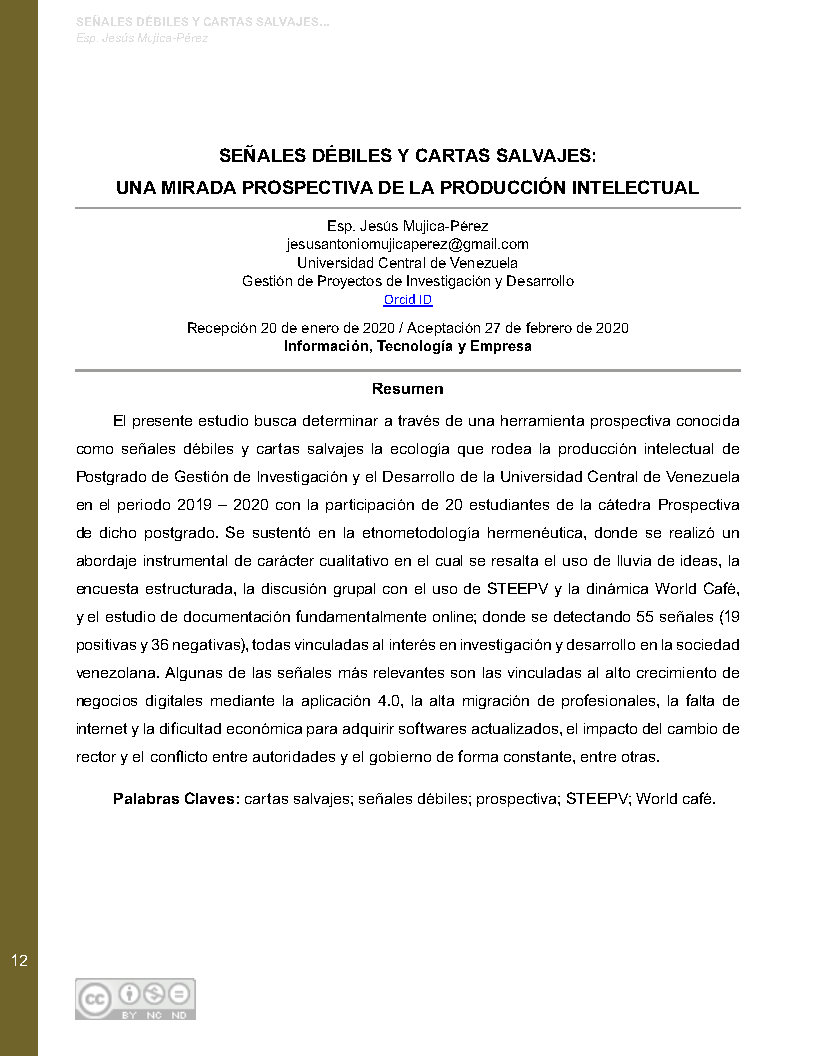Weak signals and wild cards: a prospective look at intellectual production
Keywords:
cartas salvajes, señales débiles, Prospectiva, STEEPV, World caféAbstract
This study aims to determine the ecology surrounding intellectual production in the Postgraduate program in Research and Development Management at the Central University of Venezuela during the 2019 – 2020 period, through a prospective tool known as weak signals and wild cards. Counting on the participation of 20 students from the postgraduate chair in Prospective, it was based on hermeneutical ethnomethodology, in which a qualitative, instrumental approach was undertaken. In this approach, brainstorming, structured surveys, group discussions using STEEPV and World Coffee dynamics, and mainly online documentation were used. Fifty-five signals (19 positive and 36 negative) were detected; all of them associated with interest in research and development in the Venezuelan society. Some of the most relevant signals are those related to a huge growth of digital businesses through the 4.0 application, a considerable migration of professionals, limited Internet access, and economic difficulty to purchase updated software; in addition to the impact of changing rectors, constant conflict between authorities and the government, among others
Downloads
References
Calidad de Emprendedores. (s/f). Método de Analisis Del Entorno de la Organizaciòn: FODA, STEEP y STEEPLE. Obtenido de https://calidadparaemprendedores.com/2017/07/10/metodos-de-analisis-del-entorno-de-la-organizacion-foda-pest-steep-y-steepl
Cervantes Benevides, L. E. (2016). La producción intlectual: innovación y tecnología. Revista Iberoamericana de Contaduría, Economía y Administración, 5(10).
Global & Strategis. (2007). Four Scenarios of Malaysia-Indonesia Migration: From the Status Quo to the Wild Card Scenarios. Global & Strategis. Obtenido de http://journal.unair.ac.id/download-fullpapers-jgs4e1e981421full.pdf
Godet , M., & Durance, P. (2007). Prospectiva Estratégica: problemas y métodos. Donostia-San Sebastián: Parque empresarial de Zuatzu- Edificio Urumea. Obtenido de http://www.laprospective.fr/dyn/francais/memoire/Cajadeherramientas2007.pdf
Griol, I., Milla, S., & Millet, J. (2018). Implementación de un sistema de detección de señales debiles de futuros mediante técnicas de textos. Revista Española de Documentación Científica.
https://www.devontechnologies.com. (s.f.). Busca en la web mejor: DEVONagent para Mac. Obtenido de https://www.devontechnologies.com/apps/devonagent
Kononiuk, A., & Magruk, A. (2015). Wild cards in Polish foresight practice. SciencieDirect, www.sciencedirect.com.
Martìnez Miguélez, M. (2009). Ciencia y arte en la metodología cualitativa. Mexico: Trillas.
Oliveros, Y. (2019). Brainstorming: Herramienta de Investigación Prospectiva; Guía de uso . Caracas .
Schoemaker, P., & Day, G. (2009). How to make sense of weak signals. Mit Sloan Management Revierw, 50(3). Obtenido de www.sloanreview.com
Sokolova, A., & Ponomareva, J. (2015). The identification of weak signalsand wild cards in foresight methodology: stages and methods. University Higher School of Economics (HSE).
Takala, A., & Heino, O. (2017). Weak signals and wild cards in water and sanitation services – exploring an approach for water utilities. Cross Mark. Obtenido de file:///D:/materias%20para%20el%20doctorado/Prospectiva/Weak_signals_and_wild_cards_in_water_and_sanitatio.pdf
The World Café. (s/f). Una guía rapida para ser anfitrión de Word Café. Obtenido de http://www.theworldcafe.com/wp-content/uploads/2017/11/Cafe-para-llevar.pdf


